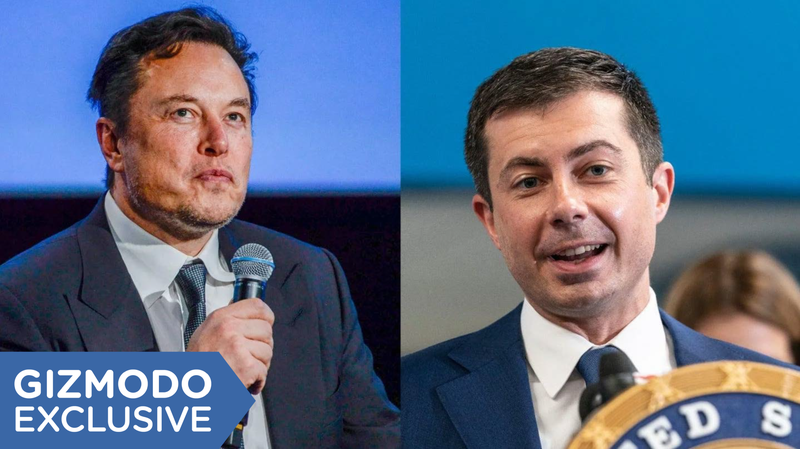Pete Buttigieg on Elon Musk's Hyperloop: 'Not on Our Dime'

- Oops!Something went wrong.Please try again later.
Elon Musk (L) and Pete Buttigieg don’t see eye to eye on the future of high-speed transit.
U.S. Department of Transportation Secretary Pete Buttigieg says that although Elon Musk’s “Hyperloop” idea is “super interesting,” he doesn’t believe government money should fund it. “Sure, try it,” he said, “but we’ll probably not try it on our dime.”
Elon Musk first floated the idea of a Hyperloop about a decade ago. His concept of a pneumatic tube-type train tunnel that uses vacuum power to propel passengers to their destination at hundreds of miles per hour was compelling enough that it helped derail California’s plans to build an actual high speed train network using existing, proven technology.
Read more
But 10 years later there is no Hyperloop connecting LA to San Francisco, or anywhere to anywhere else. The closest the billionaire has gotten to seeing his vague vision through is a slowly expanding tunnel network beneath the Las Vegas strip where you can ride in a Tesla at 35 mph. So it’s not surprising that the federal government doesn’t consider Hyperloop a sound investment.
In a Q&A session at Gizmodo’s offices in New York City on Monday, Buttigieg outlined the Biden administration’s approach to emerging transportation technologies. “We’re all about exciting ideas that could make a difference,” Buttigieg said. “But whether we’re talking about [electric vehicles] or high speed rail, technologies that exist today—that could make a difference today—is where we have to begin.”
Buttigieg has concerns regarding the Hyperloop’s technology
Buttigieg added that the most obvious flaw of Hyperloop systems is that the tech hasn’t been proven to work in the real world —and that he’s “got some questions” about the feasibility of the system’s vacuum design.
That’s a major sticking point for many critics of Hyperloop technology. The system’s big idea is passenger coaches running at high speeds in a low-pressure, near-vacuum tunnel, where there’s little air resistance. But long distance sealed tunnels would be difficult to maintain and potentially deadly if constant pressure isn’t maintained.
Another frequent criticism of the technology: The all-hype, no-proof scheme has become a distraction from actual advances. Buttigieg noted that the United States has no dedicated high speed rail lines.
The United States has catching up to do in high speed rail
Compared with other developed nations (and some countries considered “developing”), the U.S. lags far behind in the quality, functionality, and extent of its mass transit. Uzbekistan has more than 370 miles of passenger rail capable of running at 155 mph. Turkey has nearly 500 miles of fast trains, and another 750 miles of track under construction. In China and Europe, thousands of miles of high speed rail form a nexus of rapid transportation. Yet, car-centric America has zero comparable lines: Even the “high speed” NYC to D.C. Amtrak Acela route averages speeds of only 66mph.
“Why should a European citizen or a Japanese citizen or, for that matter, someone in Turkey or Morocco have access to better passenger rail? There’s no good reason,” Buttigieg said.
As the car-fueled climate catastrophe unfurls before us, it’s increasingly clear that we need mass transit to take us into a greener future. The all-individual electric vehicle boom likely can’t solve the problem of transportation carbon emissions alone. In most cases, fossil fuels still power electric vehicles. There also aren’t enough EV’s to meet current demand, let alone an all-electric future. And it’s unclear where we’re going to find the minerals and metals needed to increase production.
Funding from the Inflation Reduction Act could help improve railways
If Buttigieg and the rest of the Biden administration follow through on their plans better than Musk has with the Hyperloop, change could be coming—even if it’s 10 years late. Although high speed rail plans got cut from the landmark climate-focused Inflation Reduction Act, Biden’s 2021 infrastructure law included $66 billion for rail funding. That money would be a start towards better, faster, bigger train networks nationwide.
Right now, “we’re not even doing what people in Europe or Japan would consider regular speed rail,” Buttigieg said. “So let’s make sure we’re making the most of the opportunities using the technologies that are available here. And then, if there are transformative things emerging that could leapfrog what we’re used to and take us to the next level, great. But prove it.”
“We’re definitely not going to slow down a great investment now because we might be able to do [Hyperloop] later,” Buttigieg said.
More from Gizmodo
Sign up for Gizmodo's Newsletter. For the latest news, Facebook, Twitter and Instagram.

